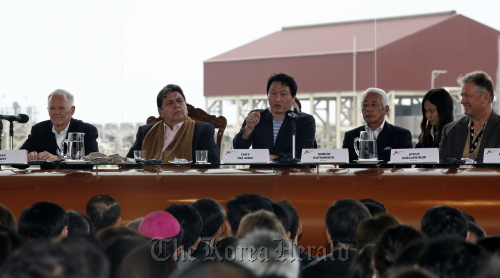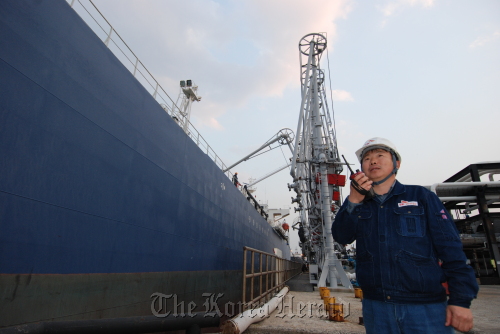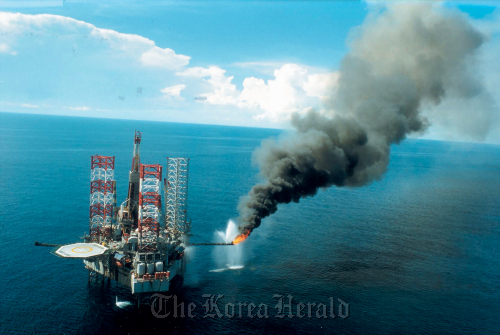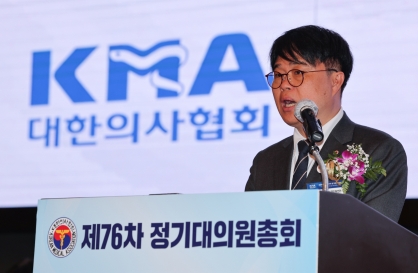Conglomerate shores up future with resource and petrochemicals business
SK Group has come to be the country’s third largest conglomerate fueled by its petrochemical and telecommunications businesses.
The two sectors are often referred to as the conglomerate’s two pillars, but the group has now turned its eyes to a new field that will compliment various parts of its existing business and drive its growth in coming years.
The new field, which the group’s chairman Chey Tae-won has taken a personal interest in, is overseas resource development.
SK Group has come to be the country’s third largest conglomerate fueled by its petrochemical and telecommunications businesses.
The two sectors are often referred to as the conglomerate’s two pillars, but the group has now turned its eyes to a new field that will compliment various parts of its existing business and drive its growth in coming years.
The new field, which the group’s chairman Chey Tae-won has taken a personal interest in, is overseas resource development.

The group’s raw materials business began in earnest September last year when its trading arm SK Networks invested $700 million in the Brazilian iron ore miner MMX.
Since then, Chey has focused on expanding his group’s global networks.
In January, Chey spent two weeks touring Australia and Brazil, during which he inspected mines the company has invested in, as well as other business opportunities such as industrial complexes in Brazil, the company said.
At present SK Group holds between 5 percent and 25 percent in four coal mines in Australia. The group’s stakes in the four mines equate to about 2 million metric tons of coal per year, the company said.
“Since the chairman began pushing the resource development project, SK Group’s revenues from related businesses broke the 1 trillion won mark for the first time last year,” said a senior vice president of SK’s brand management office.
“With him visiting resource-rich countries that are seeing trillions being invested in the field, the chairman’s global management on resource development will play an increasing role.”
While SK Group’s overseas coal projects have gained most attention from the media, its projects include a wider range or resources.


One such project is the rubber plantation operated by the group’s trading arm SK Networks.
In March 2009, SK Networks received the license to operate a rubber tree plantation in Indonesia for 60 years.
The company has so far completed planting rubber trees in 20 percent of the 15,000 hectare plantation, and plans to plant further 5.8 million trees by 2013.
SK Group’s refiner SK Innovation is also playing a major role in the conglomerate’s drive to become a major player in resource development.
SK Innovation holds 20 percent stakes in a liquefied natural gas processing plant in Peru. The plant, completed in June last year, is capable of producing 4.4 million metric tons of the fuel on an annual basis, and with SK Innovation having rights to two natural gas reserves in the Latin American country, its completion is considered to have consolidated SK Group presence in the region.
In addition, SK Group officials say that the Peru project is a prime example of the “SK-style resource cooperation,” which Chey considers as the most efficient model for resource development.
“SK-style resource cooperation is a win-win model for cooperation between a country and a company,” a SK Group official said.
“SK Group contributes to a country’s economic development with its technologies various fields including energy, chemicals, information communication and construction, while the concerned country supports SK in securing natural resources.”
While the group is seeking to become a major player in resource development, its petrochemical businesses continue to play an important role for the conglomerate.
According to the company its sales is estimated to come in at about 110 trillion won, more than 20 times larger compared to the figures from 20 years ago, much of which is attributable to its petrochemicals businesses.
The group’s petrochemicals businesses stand out in that they were organized into a vertically integrated model ahead of the competition.
The business model – where each component company produces different products used by other units – for SK Group’s petrochemicals businesses was completed in June 1991.
The model was realized when the group completed nine factories ranging from a refinery to a chemicals plant to those producing fabrics at the SK complex in Ulsan, allowing the group to consolidate its position in the local market.
In addition, the business model also formed the basis for entering the global market, with Chey driving related efforts.
With its chairman focused on overseas expansion, the group made bold investments in both domestic and overseas facilities.
The group invested 2 trillion won in building a second residue fluid catalytic cracker facility in Ulsan, and injected more than $100 million into establishing production facilities in Indonesia.
“The chairman’s large scale investments led to the globalization of the petrochemicals business, which had been restricted to the local market,” SK Group said.
“Investing in overseas resources led to revenues generated abroad, and the investments into refineries improved the quality of products, which in turn increased export competitiveness.”
According to the conglomerate, the combined sales of its petrochemicals businesses came in at about 4 trillion won, of which 1 trillion won was raised from exports, in 1991. In the following years, the overall sales figure was maintained above 10 trillion won. In 2005, the figure soared to about 21.9 trillion won, of which 10.7 trillion won was raised from exports.
The proportion of SK Group’s petrochemicals businesses’ sales continued to grow to account for more than 60 percent of the total for last year.
Last year, the combined revenues of concerned companies came in at 45.87 trillion won, of which 27.72 trillion won was raised from exports.
“Compared to the first year of vertical integration, sales jumped 11 fold and exports increased 27 fold,” the company said.
The group says that the eight docks located within the complex in Ulsan have played an essential role in shipping products abroad.
According to the company, the facilities are capable of loading 40,000 barrels of products per hour. However, despite the capacity being one of the largest in the world, ships from China, Russia and other parts of the world are said to be backed up due to the sheer volume of orders.
“In terms of the vessels capable of carrying 300,000 barrels, about 30 such vessels use the docks each month, whereas 10 years ago less than 15 vessels docked each month,” an SK Group official said.
By Choi He-suk (cheesuk@heraldcorp.com)





![[Weekender] How DDP emerged as an icon of Seoul](http://res.heraldm.com/phpwas/restmb_idxmake.php?idx=644&simg=/content/image/2024/04/25/20240425050915_0.jpg&u=)



![[Music in drama] An ode to childhood trauma](http://res.heraldm.com/phpwas/restmb_idxmake.php?idx=644&simg=/content/image/2024/04/25/20240425050929_0.jpg&u=)








![[Herald Interview] Mistakes turn into blessings in street performance, director says](http://res.heraldm.com/phpwas/restmb_idxmake.php?idx=652&simg=/content/image/2024/04/28/20240428050150_0.jpg&u=20240428174656)
